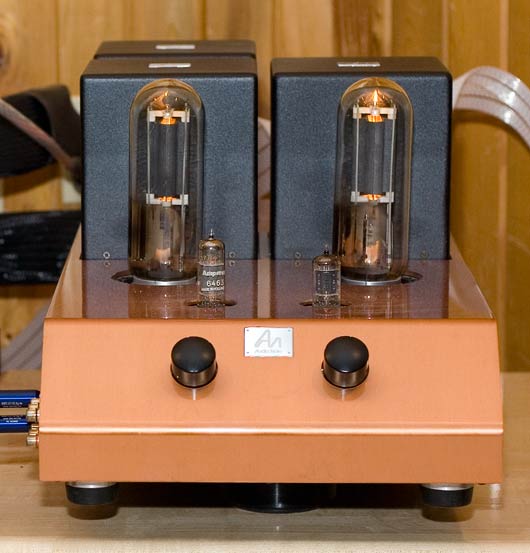Here are some photos of the new EMM Labs TSD1 transport and DAC2 DAC we are taking to RMAF 2008 in a few weeks.
Here is the blurb sent to us which will fill you in on some of the particulars:
“The chassis is completely machined thick aluminum in gorgeous brushed silver with matching metal remote when bought as a set completely redone and retooled from the CES units so they look and feel a lot better and seamless.
The DAC2 is our next generation converter with a host of digital inputs and can be used EASILY with ANY digital source. It has Ed’s MFAST technology that allows it to completely get rid of source jitter and phase distortion inherent in all 2 or multibox systems and acquire audio seamlessly in milliseconds even from the most difficult sources like Satellite Radio, DVB, Computer systems, portable media players etc. It also has all of Ed’s prior technologies, MDAT up-conversion technology where incoming audio is up-sampled to 2X SACD (5.6Mhz) and Ed’s discrete custom built DA converters all built on composite aerospace EMMbed PCB circuit boards. Along with the regular I/O like AES, SPDIF, TOSLINK etc. it also has USB Audio port for connection directly to computers and music servers.
The TSD1 is has the built in MDAT up-converter and 2008 German drive plus it sports the new transport software and LCD screen. It also has the new single fiber EMM Link for interconnection between it and the DAC2.”
DAC2 MSRP is $9,500 US
TSD1 MSRP is $11,000 US
We can testify that when you look at them [and especially when you pick them up :-)] you can see that they are made with a thick aluminum chassis that feels very solid and robust.
First impressions, after about 3 whole hours(!) of playing [with :-)] them is that they are very lively like the CDSA but more so [through-out the entire note], that the notes are very well controlled throughout the entire note – something that neither analog nor digital has really contributed to in my experience [instead, we rely on uber amplifiers to do the best that can be done with the signal they are given], and a very black background [the honorable competition, and even the Emm Lab’s own CDSD/DCC2 pair to some lesser extent, seems to try and fill in the background with a lot of extra information – amplifying the quiet sounds so they do not get lost, or to please the listener with a sense of higher resolution – similar to the tipped up midrange on showroom speakers and tipped up contrast on showroom TVs? I don’t know but the digital revolution is still advancing at a rapid pace and this sounds like this will be de’rigeur in a few years. The feeling is that there is a lot more separation between the subtle notes].
But it has only been THREE HOURS. Right now we have to listen around the Cold New Player Effect – things will likely get even better if past experience [with new players] is any predictor of the future experience [improvements associated with broken-in players]. Already I think both Neli and I prefer this pair over the previous Emm Labs digital [and we preferred THAT over other digital we have heard – with the POSSIBLE exception of the Esoteric P-01/D-01/G-0s, which is much more expensive [at $60K+] and we would have to hear much more closely to get a feeling which is ‘better’, or just ‘different’. But this *is* the league EMM Labs is playing in – the best in the world.].
More in a few hundred hours or so. Or come to the show and hear for yourself 🙂

The TSD1 transport

The TSD1 transport turned on

The TSD1 rear panel

The DAC2

The DAC2 rear panel

The new remote

The new remote next to the remote that comes with the CDSD/DCC2. Not as wide, same thickness, and without volume controls… Both feel great in the hand
[unlike Sony XBR remotes – boy, my mute button is already squished in after 2 weeks of use. What a POS remote – and these are their top-of-the-line LCDs too].













